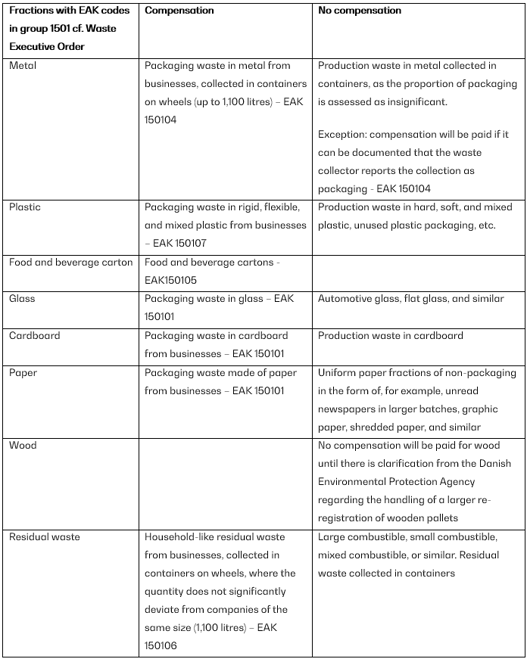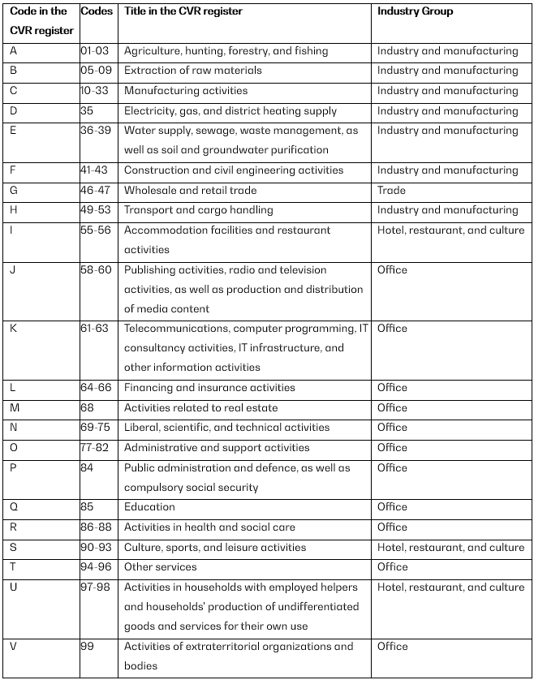Compensation for commercial waste
The waste-producing company has the practical responsibility for ensuring that the packaging waste is waste treated. The packaging waste is normally handed over to private waste collectors.
Compensation
The following points are clarified in the model below:
1. Producers have the financial responsibility for the packaging they place on the market, which ends up in commercial waste. They pay costs for this to the producer responsibility organisation (PRO) they are a member of.
2. Waste-producing companies can seek compensation for their expenses related to the collection and treatment of packaging waste. The company still pays for the part of the waste that is not packaging.
3. The producer responsibility organisation (PRO) pays compensation for the costs of handling commercial packaging waste to one of the following:
- waste-producing company
- waste collector, who applies on behalf of their customers.
VANA is working on the specific model for compensation payment and updates regularly.

How to Request Compensation
To make it easier to apply for compensation, you can follow the steps via the headings below, which you can expand.
The waste-producing company must apply for compensation from the producer responsibility organisation (PRO) assigned the payment obligation in the municipality where the company is registered according to the company's P-number. The company's P-number is registered in the CVR register. The P-number can be found by searching on cvr.dk with the company's name or CVR number.
If the company has activities at multiple addresses/P-numbers, the application must be sent to the producer responsibility organisation (PRO) that is assigned the payment obligation at the address (P-number) where the packaging has become waste.
The fractions that can be applied for are:
- cardboard packaging waste
- paper packaging waste
- metal packaging waste
- glass packaging waste
- plastic packaging waste
- food and beverage carton packaging waste
- wood packaging waste
- packaging waste correctly sorted as residual waste
- packaging waste in hazardous waste.
The table below shows which fractions VANA pays compensation for and which fractions it does not pay compensation for:

Compensation is paid for the following combined fractions according to the guidelines described above:
- Cardboard + paper
- Plastic + food and beverage carton
- Plastic + metal + food and beverage carton
- Metal + glass
If a waste-producing company has packaging waste that falls outside the described guidelines, please contact VANA at kompensation@vana.dk.
The waste-producing company cannot apply for compensation for:
Returned quantities
- Companies that have established a take-back scheme and take back their own and similar packaging that has become packaging waste cannot apply for compensation for the collection, transport, and treatment of packaging waste that originates from the company's made available packaging.
Waste that is part of a municipal collection or drop-off scheme
- Waste-producing companies that have their waste collected as part of a municipal household collection, or that drop off their waste in a drop-off scheme (recycling stations), cannot apply for compensation.
- Waste-producing companies that have their waste collected by a municipality that collects commercial waste separately from household waste cannot apply for compensation, as the right to compensation has been transferred to the municipality.
Packaging waste sold for profit
- The Ministry of the Environment has indicated that: "if one as a waste-producing company has a completely clean load of packaging waste that can gain a total profit from sale, one should not request payment". VANA is in dialogue with the authorities to clarify how this should be interpreted and handled in practice.
To calculate how much the producers (via VANA) must pay to the waste-producing companies for commercial packaging waste, the Danish Environmental Protection Agency sets key figures that are regulated once a year.
Find the key figures on the Danish Environmental Protection Agency's website
Calculation
VANA calculates the payment for collection, transport, and treatment of commercial packaging waste from waste producers using the formulas below:
- Amount to be paid = number of tons * allocation key for packaging share * (key figure for collection + key figure for treatment).
For combined collection, the following formula is used:
- Amount to be paid = number of tons * allocation key for combined collection * allocation key for packaging share * (key figure for collection + key figure for treatment).
Definitions of terms for calculation formulas
Number of tons is the quantity of waste that the waste producer has produced and requested payment for within the given payment period.
The allocation key for packaging share refers to the allocation keys that are shown in Tables 4-7 in Annex 8. The producer must use these allocation keys when calculating costs.
The allocation key for combined collection refers to the allocation keys shown in Table 2 in Annex 8 for waste fractions collected via municipal collection schemes that are collected through combined collection. The producer must use these allocation keys when calculating costs.
Key figures for collection and key figures for treatment constitute a total market price for collection, transport, and treatment, including also pre-treatment and marketing of waste materials. When calculating the payment, the producer must use key figures for costs related to respectively collection and treatment, as determined by the Danish Environmental Protection Agency.
The Danish Environmental Protection Agency sets key figures for the collection and treatment of commercial waste based on a base figure for a current market price for treatment and transport respectively.
The base figures are continuously price-regulated, among other things by using indices for sales prices, and multiplied by price efficiency factors to adjust the key figures downwards so that they reflect efficient collection and marketing.
A request for compensation must be submitted to VANA via kompensation.vana.dk. In order to request compensation, the user must be logged into VANA's compensation portal with MitID Erhverv and granted the right "Right to request compensation from VANA" from Signaturgruppen.
The request must be submitted in a csv file with the following format and content (the image below is in Danish):
![]()
A template for the file can be downloaded at kompensation.vana.dk.
A request must be submitted for each collection date and for each fraction. For example, if the waste-producing company has packaging waste collected four times in a month, where paper and metal are collected each time, a request must be submitted for each fraction and each collection - a total of eight requests. Multiple requests can be combined into a file, where each line is a request.
The following information must be submitted for each collection in the request:
- CVR for the waste collector
- CVR number and P number for the waste-producing company
- Collection date
- Industry group
- Fraction
- Quantities of packaging waste requesting compensation for in kg
- Invoice number that can document the stated quantities broken down by fractions
- Item number according to the invoice. In the absence of an item number, the item name/description should be noted
- Own reference
Filling out the last column is optional. The field can be used to enter the company's own reference. If there are requests in the file that cannot be approved, for example, because there are errors in the uploaded file, or they are submitted too late compared to the collection day, the waste-producing company will receive an email with a link to a specification of which requests have been rejected. If there are errors in the rejected requests that can be corrected, the corrected requests can be uploaded again. The original file must not be uploaded again.
The industry group that should appear in the application is not identical to the industry code registered in the CVR number register.
The industry groups are:
- Industry and manufacturing
- Office
- Trade
- Hotel, restaurant, and culture
The waste-producing company must find its industry group using the first two digits of the industry code with which it is registered in the CVR number register and the table below. For example, a company with the industry code 10.51.00 (10) is in the industry group "Industry and manufacturing" according to the overview below.

As documentation for the quantity of packaging for which compensation is requested, the waste-producing company must upload the invoices that have been paid in connection with the collection and treatment of the packaging.
If multiple requests relate to an invoice, the invoice should only be uploaded once. The invoices must be uploaded in PDF format. There must be consistency between the invoice numbers indicated in the submitted file with requests and the invoices that are uploaded.
When the waste-producing company has submitted a file with requests, the company will receive a confirmation via email with a link to an overview of the requests and quantities that VANA has received. The reference to a submitted file is referred to as FILE ID, e.g., 124589, and it appears in the email with the confirmation of the submitted requests. It may take a moment before the company can see the registered requests in the compensation portal.
If the waste-producing company discovers an error in a request that has been submitted, the request must be canceled. Cancellation must occur in the compensation portal in the same screen where the status of the submitted requests can be seen. Here, the status code "Received" must be changed to "Cancelled" for the request that VANA should disregard.
A request can be canceled until it has been approved by VANA and set for payout. The company cannot reverse a registered cancellation. When a request is canceled, the waste-producing company receives an email confirming the cancellation.
If an error is discovered after the compensation has been paid out, the waste-producing company can correct the error by creating a new request corresponding to the request that contained the error, BUT with the amount indicated as a negative value. The associated invoice must be uploaded again.
Corrections to a request can be made up to 12 months after the collection date. The waste-producing company will not receive an email if the cancellation has been made in the manner described last, but the cancellation can be seen on the request status screen.
In the compensation portal, the waste-producing company can see the status of the requests that the company has submitted to VANA.
A. Received
B. Cancelled
C. Rejected
D. Set for payment
When a request is submitted to VANA, it receives the status "Received". When VANA has approved the request, the status changes to "Set for payment". If the waste-producing company cancels the request before it is set for payment, it will receive the status "Cancelled". If VANA cannot approve the request for compensation, it will receive the status "Rejected".
Requests submitted in the same file will, as a rule, be settled on the same settlement note. The FILE-ID appears as a reference on the settlement note, which is sent to the waste-producing company by e-mail. The compensations will be paid out to the company's NemKonto no later than 30 days after the submission date.
VANA can change a decision on a request that has been paid out if it turns out that the decision is not correct. The waste-producing company will receive a charge for the amount that has been corrected. The amount must be paid if it cannot be offset against the waste-producing company's claims with VANA.
If VANA changes a decision, the waste-producing company will receive an email with a link to a specification of the changed requests. On the settlement document, there is a link to an overview where the paid-out amount is specified for the requests.
Key figures for commercial packaging
Compensation to the waste-producing companies is calculated, among other things, by using Miljøstyrelsen's key figures and the distribution keys specified in the statutory order on packaging.
The key figures cannot be equated with the prices that the companies must pay for handling commercial waste, as other factors also contribute to the price calculation.
